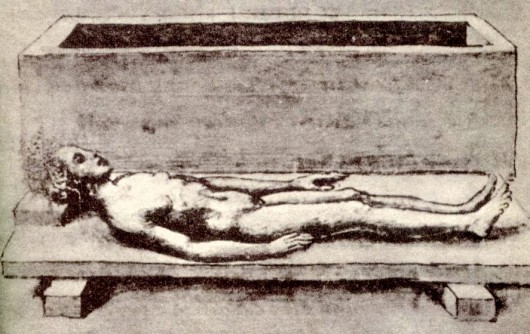Further on from my post "Henri IV of France Identified" back in 16th December 2010 and the post from Live Science of 14th December 2010 (Mummy Head (and Brain) Identified as Long-Lost French King), comes this series of articles now doubting the identification of the royal skull.
PhysOrg: French King Henri IV's Head Stars In Forensic Dispute:
Doubt - and a reportedly royal severed head - haunts a murky corner of forensic science these days, as researchers squabble over an unearthed packet of mummified remains thought to have belonged to King Henry IV of France.
At the heart of the macabre drama is an embalmed head with several vertebrae still attached. The remains were found in 1919 in the Royal Basilica of St. Denis outside Paris and reportedly secreted away by a civil servant. Reappearing almost a century later, the specimen still had its soft tissue and organs intact, right down to the open mouth and partially closed eyes.
From the South China Morning Post: Forensic scientists in debate over head of King Henry IV of France:
Obtaining a sample of the mummified tissue, they conducted a genetic analysis and compared it with DNA samples given by three male descendants. Analysing the Y chromosome of the three descendants, and genes that reveal matrilineal descent, they found similarities among the three descendants. But none matched the disembodied head.
The team further compared the Y chromosome taken from the mysterious head with that taken from a blood-soaked handkerchief said to contain the genetic material of Louis XVI. The two samples did not match.
From Newser: Does This Head Belong To France's Henri IV?
Forensic researchers have a royal dispute on their hands: They can't agree on whether a mummified head belongs to France's Henry IV, explains the Los Angeles Times. The question seemed settled in 2010 when a team of researchers used facial-reconstruction techniques to conclude that it was indeed "Good King Henry," who was assassinated in 1610. But now a second team of scientists says it isn't so because DNA tests don't match Henry's living relatives.
From Fox News - Live Science: Lost Kings: DNA Fails To Solve History Mysteries:
The tale of the head and the gourd, however, is not quite so straightforward. In 2010, a forensic analysis suggested the head belonged to French King Henry IV. DNA later linked the head to the blood in the gourd, leading researchers to identify the blood's owner as Henry's descendant, French King Louis XVI. Now, however, a second DNA analysis has thrown those findings into disarray, suggesting perhaps the head and the blood belong not to royalty, but to nobodies.
From The Independent: Academics Scratch Heads Over Mystery of French King's Skull:
Four academics – including two who contributed to a report in the British Medical Journal which claimed a skull found in 1919 was the head of Henri IV – have now challenged the research after new DNA tests cast doubt on the authenticity of the remains.
The original report, published in the BMJ in December 2010, saw France’s pre-eminent forensic examiner, Dr Phillipe Charlier, and his team identify the partly preserved severed head as that of the monarch, who was assassinated in 1610 and is famous for ending the country’s religious wars.
From UPI: Forensic Researchers Debate Whether Head Belongs To Henry IV:
Forensic researchers have a royal dilemma on their hands: They can't reach consensus on whether a mummified head belongs to Henry IV of France.
In 2010, a team of researchers used facial-reconstruction techniques to conclude that it was indeed "Good King Henry," who was assassinated in 1610.
The case seemed closed.
Now, a second team of scientists says it can't be the royal head, since DNA tests do not match Henry's living descendants.










